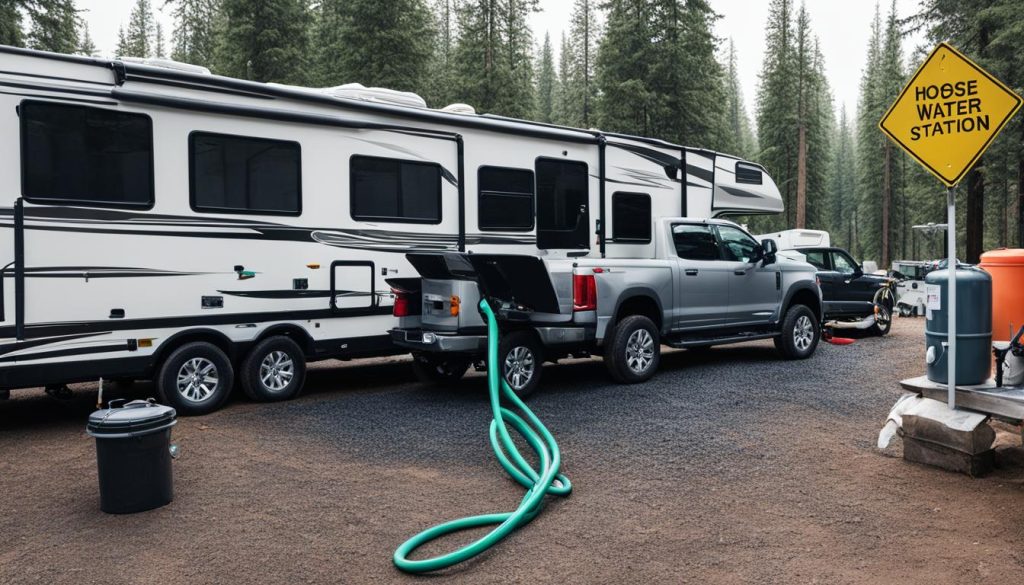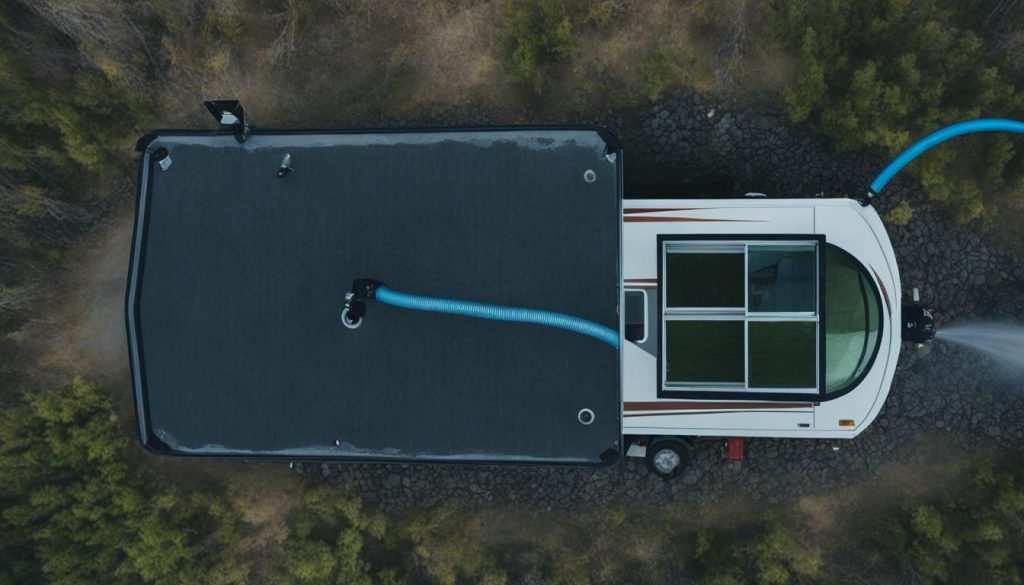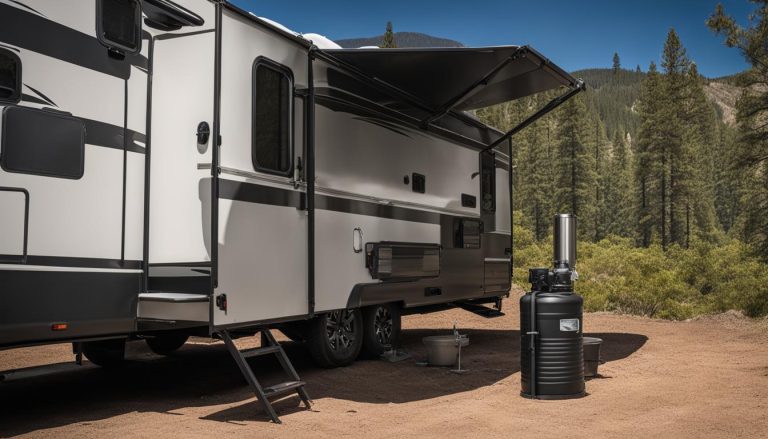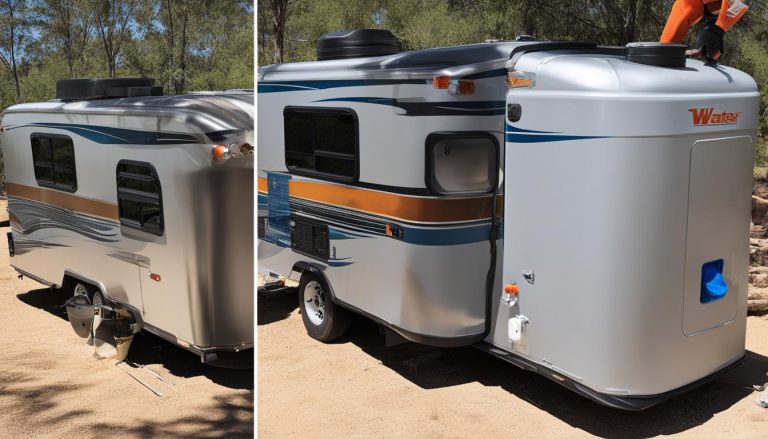Understanding RV Grey Water Basics
gorvlifestyle.com and its partners may earn a commission if you purchase a product through one of our links
When it comes to your RV’s plumbing system, it’s crucial to have a clear understanding of how things work, especially when it comes to grey water. Grey water refers to the wastewater generated from sinks and showers in your RV, excluding the toilet waste. This water typically contains soap, dirt, and food particles, but is relatively clean compared to black water.
Knowing how to manage, store, and dispose of RV grey water is essential for maintaining a clean and functional RV system. From understanding the components of your grey water tank to proper disposal techniques, here’s everything you need to know.
Key Takeaways:
- RV grey water consists of wastewater from sinks and showers, excluding toilet waste.
- Understanding how your grey water tank works is vital for proper maintenance and functionality.
- Regularly emptying and cleaning your grey water tank helps prevent odor buildup and system issues.
- Flushing and maintaining your grey water tank regularly keeps it clean and reduces odors.
- Consider using portable grey water tanks for easy disposal, especially in areas without sewer hookups.
RV Grey Water Tank: What Does It Look Like?
When it comes to understanding how rv grey water works, it’s important to know the basics of the rv septic system. This system typically consists of three tanks: the fresh water tank, the grey water tank, and the black water tank.
The fresh water tank holds clean water for faucets and showers, ensuring a reliable water supply during your travels. The grey water tank, on the other hand, is responsible for storing the wastewater from sinks and showers. It collects relatively clean water that may contain soap, dirt, and food particles, but not waste from the toilet.
Now, you might be wondering where the waste from the toilet goes. That’s where the black water tank comes into play. It holds the waste from the toilet, ensuring proper containment and disposal when needed.
It’s important to note that not all RVs have a separate grey water tank. Some older or smaller RVs may have a combined tank, meaning that all waste water, including from sinks, showers, and toilet, goes into one tank – the black water tank.
To give you a clearer picture, here’s a breakdown:
| Tank | Contents |
|---|---|
| Fresh Water Tank | Clean water for faucets and showers |
| Grey Water Tank | Water from sinks and showers (no toilet waste) |
| Black Water Tank | Waste from the toilet (separate tank) |
Properly maintaining each tank is crucial to ensure the smooth operation of your RV’s plumbing system. Regularly emptying and cleaning the tanks and following the manufacturer’s guidelines will help prevent any unpleasant issues that may arise.
RV Grey Water Disposal: How Often Should You Empty the Tanks?
Properly managing and disposing of RV grey water is crucial for a clean and functional RV system. The frequency of emptying your RV grey water tanks depends on your usage and the number of people in your group. Here are some guidelines to help you determine how often you should empty your tanks:
Group Size and Usage
If you’re traveling with a large group or have frequent guests in your RV, you’ll likely generate more grey water. In this case, it’s recommended to empty your tanks every other day to avoid overfilling and potential issues.
For couples or smaller groups, emptying the tanks once a week is usually sufficient. This allows you to maintain a reasonable level of grey water in the tanks without compromising your RV’s functionality or creating unpleasant odors.
Waiting for Two-Thirds Full
As a general rule, it’s best to wait until your RV grey water tanks are about two-thirds full before emptying them. This level provides an optimal balance between efficiency and convenience during the dumping process. Emptying the tanks when they are too full or too empty can lead to problems such as clogs or ineffective flushing.
Sensor Reliability
Many modern RVs are equipped with sensors that indicate the level of grey water in the tanks. However, it’s important to note that these sensors may not always be reliable. Factors such as sensor malfunctions or debris buildup can affect their accuracy. Therefore, it’s essential to be aware of your water usage and visually inspect the tank levels to ensure you don’t exceed their capacity.
RV Grey Water Disposal: How Often Should You Empty the Tanks?
In conclusion, the frequency of emptying your RV grey water tanks depends on your group size, usage, and the level of convenience you prefer. Remember to regularly monitor your tank levels, aim for about two-thirds full before emptying, and be mindful of any signs of sensor malfunctions. By properly managing your RV’s grey water disposal, you can ensure a hygienic and functional RV system throughout your travels.
How to Properly Empty and Maintain RV Grey Water Tanks
Emptying RV grey water tanks is a simple process that ensures the cleanliness and functionality of your RV system. Follow these steps to properly empty and maintain your grey water tanks:
- Start by identifying the valves on the outside of your RV for the grey and black tanks.
- Connect a sewer hose to the valve for the grey tank and secure the other end to the dump station.
- Open the valve and let the tank drain completely before closing the valve.
- For easy clean-up, detach the sewer hose slowly and use a bucket or tub to contain it when not in use.
Regular maintenance of your RV grey water tanks is essential for proper storage and treatment of waste water. Here are some additional tips:
- Monitor the level of your grey water tank regularly to ensure it doesn’t exceed its capacity.
- Use proper RV grey water storage methods to prevent leaks or spills.
- Consider using RV grey water treatment products to control odors and break down waste.
- Clean your grey water tank regularly to remove buildup and prevent clogs.
Properly managing and maintaining your RV grey water tanks not only keeps your living space clean and comfortable but also contributes to the preservation of the environment. Remember to always follow local regulations and guidelines when disposing of grey water.
For a visual guide on how to empty and maintain your RV grey water tanks, refer to the table below:
| Step | Description |
|---|---|
| 1 | Identify the valves for the grey and black tanks on your RV. |
| 2 | Connect a sewer hose to the grey tank valve and secure the other end to the dump station. |
| 3 | Open the grey tank valve and let the tank drain completely. |
| 4 | Close the grey tank valve and detach the sewer hose. |
| 5 | Use a bucket or tub to contain the sewer hose when not in use. |

Properly emptying and maintaining your RV grey water tanks ensures a clean and functional RV system. By following these steps and implementing regular maintenance, you can enjoy a hassle-free camping experience.
Grey Water Tank Flushing and Maintenance Tips
Properly maintaining and flushing your RV’s grey water tank is crucial to ensure a clean and odor-free camping experience. Here are some helpful tips to effectively manage your rv grey water:
- Use a hose to flush it out: Connecting a hose to your grey water tank’s outlet and allowing water to flow through can help clean the tank and remove any debris or residues. Make sure to use a hose designated for this purpose to avoid contaminating your drinking water hose.
- Pour hot soapy water or vinegar down the drain: Adding hot soapy water or vinegar into your sinks and shower drain can aid in breaking down grease, soap scum, and other build-ups. Let the solution sit for a few minutes before flushing it out with water.
- Add ice to the tank: Some experienced campers swear by adding ice cubes to the grey water tank. As you drive, the ice cubes will agitate inside the tank and help loosen any stubborn debris, making it easier to flush out during your next dumping process.
Regularly cleaning and maintaining your grey water tank will not only prevent unpleasant odors but also keep the entire RV system running smoothly. Additionally, it’s important to empty and clean the tank at least once a year to avoid any potential issues.
Tip: Flushing your grey water tank regularly is recommended every time you empty the tanks to maintain a sanitary and odor-free environment.

By following these grey water tank flushing and maintenance tips, you’ll be able to effectively manage and maintain your RV’s grey water system, ensuring a comfortable and hassle-free camping experience.
Portable Grey Water Tanks for Easy Disposal
When it comes to managing your RV grey water storage and disposal, portable grey water tanks can be a game-changer. These tanks provide an added layer of convenience for RV owners, allowing for easy transport to a dump station without having to move the entire RV.
Portable grey water tanks come in various sizes to accommodate different needs, making them suitable for all types of RVs and camping setups. Whether you prefer camping in areas without sewer hookups or you simply want to avoid the hassle of disconnecting your rig for the dump station, these tanks offer a practical solution. They enable quick and effortless disposal of your grey water, ensuring a more streamlined and convenient dumping process.
With a portable grey water tank, you have the flexibility to choose when and where to empty your tanks. Instead of relying solely on the built-in grey water tank of your RV, you can extend your stay at a campsite without worrying about tank capacity. These tanks are easy to connect and disconnect, allowing you to efficiently manage your grey water and maintain a clean and functional RV system.
FAQ
What is RV grey water?
RV grey water is the waste water that comes from sinks and showers in an RV. It does not include water from the toilet. The grey water contains relatively clean water with soap, dirt, and food particles.
How does the RV grey water system work?
A typical RV septic system consists of three tanks: the fresh water tank, the grey water tank, and the black water tank. The grey water tank holds water from sinks and showers, while the black water tank holds waste from the toilet. Some older or smaller RVs may not have a separate grey water tank.
How often should you empty RV grey water tanks?
The frequency of emptying RV grey water tanks depends on usage. For larger groups, every other day may be necessary. For a couple, once a week may be sufficient. It’s best to wait until the tanks are about two-thirds full before emptying them.
How do you properly empty and maintain RV grey water tanks?
Start by identifying the valves on the outside of your RV for the grey and black tanks. Connect a sewer hose to the valve for the grey tank and secure the other end to the dump station. Open the valve and let the tank drain completely before closing the valve. Regularly cleaning and maintaining the grey water tank will prevent odor buildup and keep the system running smoothly.
How do you flush and maintain the RV grey water tank?
Flushing your RV’s grey water tank helps keep it clean and reduces odors. You can use methods like using a hose to flush it out or pouring hot soapy water or vinegar down the drain. Some campers also add ice to the tank to help agitate and clean the inside. It’s important to empty and clean the tank at least once a year to prevent any issues.
What are portable grey water tanks?
Portable grey water tanks are additional tanks that can be easily transported to a dump station without moving the entire RV. They come in various sizes and are useful if you frequently camp in areas without sewer hookups or if you prefer not to disconnect your rig for the dump station. Portable grey water tanks allow for easy disposal of grey water and ensure a more convenient dumping process.






